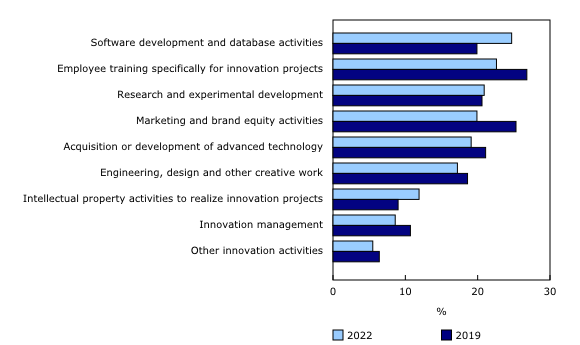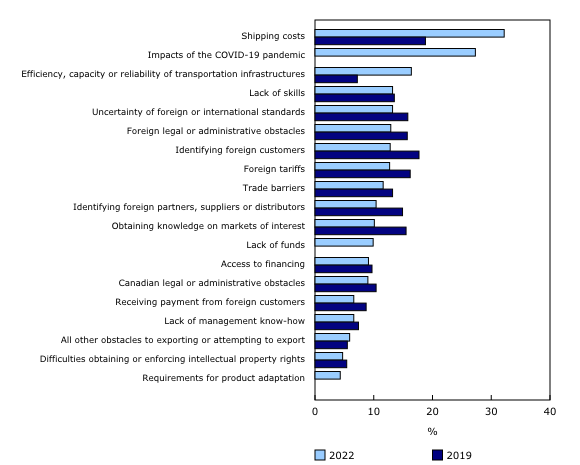Survey of Innovation and Business Strategy, 2022
Released: 2024-07-31
Innovation is essential for businesses in today's global market. By engaging in innovation activities, companies can create new products, enhance their processes, and leverage advanced technologies, enabling them to stay ahead of competitors.
Proportion of businesses conducting innovation activities drops in 2022
Innovation activities include all developmental, financial and commercial activities performed by a business with the intention of creating new products or introducing new business processes. Innovation activities can also result in the acquisition of beneficial knowledge or information without leading to the introduction of an innovation in a specific timeframe.
In 2022, the Survey of Innovation and Business Strategy revealed that software development and database activities (24.7%) were the most prevalent innovation activities. They were followed by employee training specifically for innovation projects (22.6%), research and development (20.9%), marketing and brand equity activities linked to innovation (19.9%) and the acquisition or development of advanced technology (19.1%).
Overall, the proportion of businesses conducting innovation activities declined to 47.2% in 2022, down from 52.5% in 2019. Marketing and brand equity activities linked to innovation recorded the largest decline, down from 25.3% in 2019 to 19.9% in 2022. This decline was countered by two activities that increased over this period, software development and database activities (from 19.9% in 2019 to 24.7% in 2022) and intellectual property (IP) activities (from 9.0% in 2019 to 11.9% in 2022).
The ranking of the propensity to conduct innovation activities across business size groups did not change in 2022 from 2019. Large businesses (66.5%) continued to be the most likely to conduct innovation activities, followed by medium-sized businesses (53.7%) and small businesses (45.0%).
Innovation activities are important across a range of industrial activities. In 2022, information and cultural industries (67.8%) had the highest propensity to conduct innovation activities among sectors, followed by manufacturing (64.5%), professional, scientific and technical services (62.7%) and utilities (58.3%).
Businesses with deeper transnational relationships seemed to be more likely to engage in innovation activities in 2022, and multinational businesses were more likely to conduct innovation activities than non-multinational businesses. In 2022, over 6 in 10 multinational businesses (66.9%) conducted innovation activities, compared with approximately 4 in 10 non-multinational businesses (44.2%). In addition, the propensity to conduct innovation activities was higher among Canadian multinational businesses (78.9%) than foreign multinational businesses (61.6%) operating in Canada.
Innovation activities are an important precursor to the introduction of new products and business processes, the filing of intellectual property protection and accessing government support
Innovation activities are strongly associated with innovation. In fact, 9 in 10 businesses (89.9%) that conducted innovation activities in 2022 introduced an innovation in the 2020-to-2022 period, while this proportion falls to approximately 1 in 2 businesses (55.7%) for those that did not conduct innovation activities.
Filing for IP protection is a key innovation activity. Businesses that conducted innovation activities in 2022 were more apt to file to protect at least one type of IP during the 2020-to-2022 period compared with businesses that did not conduct innovation activities. Over one in five businesses (20.7%) that conducted innovation activities in 2022 filed for IP protection over the 2020-to-2022 period, compared with 3.5% of businesses that did not conduct innovation activities.
Businesses engaged in innovation activities in 2022 were also more likely to have received government support for innovation-related activities during the 2020-to-2022 period. The rate at which businesses used government programs to support innovation-related activities was over twice as high among businesses that conducted innovation activities in 2022 (50.0%) compared with those that did not (19.9%).
Participation in international trade boosts innovation
As the Canadian economy is highly integrated into the global economy, its health is influenced by global economic conditions. By fostering competition, knowledge exchange, technology transfer, cross-border collaboration and aligning incentives, international trade creates a conducive environment for innovation.
In 2022, businesses involved in international trade were more innovative than businesses that were not involved. Nearly 8 in 10 businesses (79.9%) that either imported or exported goods or services were innovative, compared with 63.8% of businesses that neither imported nor exported.
However, the proportion of businesses that engaged in international trade modestly declined in 2022 (50.1%) compared with 2019 (54.3%).
Nearly 3 in 10 businesses (29.1%) sold goods or services outside of Canada in 2022, compared with 30.6% in 2019, and over 4 in 10 businesses (44.0%) purchased goods or services from outside of Canada in 2022, down from 47.8% in 2019.
Large businesses are more adept at competing in the global market due to their significant resources, established networks, access to capital and greater capacity for innovation. In 2022, over half (52.3%) of large businesses sold goods or services outside of Canada, compared with one in four small businesses (26.5%). Large businesses were also more likely to engage in import activities compared with smaller businesses. Just over 7 in 10 (70.7%) large businesses imported goods or services, while 41.3% of small businesses did so.
In 2022, the manufacturing sector (60.2%) and the information and cultural industries sector (59.7%) had the highest proportions of businesses reporting export activities, while the construction sector (5.0%) and the retail trade sector (7.4%) had the lowest proportions of businesses involved in export activities. The wholesale trade sector (74.1%) and the manufacturing sector (71.8%) reported the highest proportions of businesses engaging in import activities.
Shipping costs, the COVID-19 pandemic and infrastructure challenges are the biggest barriers for exporters
Supply chain challenges caused by the COVID-19 pandemic and aggravated by the ongoing conflict in Ukraine since 2022 triggered additional obstacles for Canadian exporting businesses. A higher proportion of these businesses reported external barriers related to the global supply chain in 2022 compared with 2019. Shipping costs, the pandemic and transportation infrastructure barriers were the top three obstacles to exporting reported as either difficult or very difficult. The proportion of exporting businesses citing shipping costs as a significant barrier reached 32.2% in 2022, up from 18.8% in 2019. Exporting businesses were also more likely to report transportation infrastructure barriers in 2022, increasing 9.2 percentage points from 7.2% in 2019 to 16.4% in 2022. Nearly 3 in 10 exporting businesses (27.3%) reported the pandemic as a difficult or very difficult obstacle in 2022.
Did you know we have a mobile app?
Download our mobile app and get timely access to data at your fingertips! The StatsCAN app is available for free on the App Store and on Google Play.
Note to readers
The 2022 Survey of Innovation and Business Strategy (SIBS) is a joint initiative of Statistics Canada; Innovation, Science and Economic Development Canada; the Institut de la statistique du Québec; the Ontario Ministry of Economic Development, Job Creation and Trade; and the Alberta Ministry of Jobs, Economy and Northern Development.
Because of changes in terminology and content between the 2022 SIBS and previous iterations, caution is recommended in making comparisons at more detailed levels of aggregation.
Innovation is defined as a new or improved product or process (or combination thereof) that differs significantly from the businesses' previous products or processes and that has been made available to potential users (products) or brought into use by the businesses (processes).
Multinational businesses are corporations with majority-owned operations in more than one country. Canadian multinational businesses are Canadian-controlled firms with a foreign affiliate, while foreign multinational businesses are firms in Canada controlled by a foreign parent.
Intellectual property (IP) is a distinct form of creative endeavour such as an invention, creative work, image or industrial design that may be protected by legislation or that has provided commercial value. Protected IP owned by businesses covered in the SIBS includes trademarks, patents, non-disclosure agreements, trade secrets, copyrights and industrial design.
The target population for the SIBS is limited to enterprises within the following sectors defined according to the North American Industry Classification System:
- Agriculture, forestry, fishing and hunting (11)
- Mining, quarrying, and oil and gas extraction (21)
- Utilities (22)
- Construction (23)
- Manufacturing (31 to 33)
- Wholesale trade (41)
- Retail trade (44 to 45)
- Transportation (48)
- Postal service, couriers and messengers, warehousing and storage (49)
- Information and cultural industries (51)
- Finance and insurance (52) excluding monetary authorities - central bank (521)
- Real estate and rental and leasing (53)
- Professional, scientific and technical services (54)
- Management of companies and enterprises (55) excluding holding companies (551113)
- Administrative and support, waste management and remediation services (56)
To reduce response burden on small businesses, only enterprises with at least 20 employees and revenues of at least $250,000 were considered for sample selection.
Contact information
For more information, or to enquire about the concepts, methods or data quality of this release, contact us (toll-free 1-800-263-1136; 514-283-8300; infostats@statcan.gc.ca) or Media Relations (statcan.mediahotline-ligneinfomedias.statcan@statcan.gc.ca).
- Date modified:


